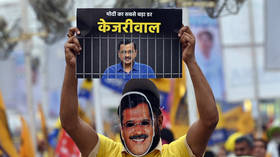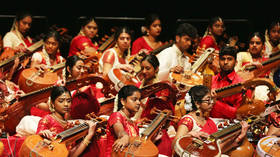The Modi factor: Tourists are flocking to Varanasi to witness the electoral battle
India’s PM hopes to re-enter India’s parliament with a majority on June 1; tour companies have been prompted to include his rallies and roadshows
When Yegor’s fingers begin to glide over his acoustic guitar, he instantly captivates a random audience at the iconic Assi ghat, a flight of steps leading down to the Ganges River, a vibrant tourist hotspot in the north Indian city of Varanasi.
However, despite his skillful renditions of Pink Floyd’s ‘Wish You Were Here’ and Nirvana’s ‘Come As You Are’, he is not the star of India’s 18th parliamentary election. That would be Prime Minister Narendra Modi, who has represented the holy city since 2014, two election cycles ago.
On June 1, about 1.96 million local voters will determine PM Modi’s fate in the constituency, and Varanasi is buzzing with activity like never before. He is clearly a favorite, even though he is from Gujarat, a state where he was Chief Minister for 13 years in western India. He is so popular that the opposition Congress party has nominated Ajai Rai for Varanasi despite his solid defeat in the 2019 election.
Each candidate is vying for one of the 543 seats in the Lok Sabha, the lower house of the national legislature. Modi’s Bharatiya Janata Party (BJP) leads a coalition which rules the country and is seeking to extend its tenure.
While surveys have indicated that Modi is popular, the biggest indication of his rockstar status is that he is attracting tourists from abroad specifically to witness his campaign for a third term as prime minister.
Foreign Tourists pay to wave at Modi’s Roadshows
“We expect (the number of) foreign tourists to Varanasi to go up by a few thousand over the next two months,” Manish Sharma of Akshar Travels, and chairman of the Tourism Corporation Society of Gujarat, told RT. “We’ve set up a six-night-seven-day election tourism package where tourists will get to learn aspects of India’s elections.”
As part of the package ranging from $ 500 to $ 1000 (excluding travel and stay), visitors will be taken to rallies held by the contestants, including Modi. They will also get a chance to wave to Modi during his road shows.
The use of elections as a niche tourism product was first experimented on in India in the Gujarat state legislature, in 2012 (when Modi was the state’s chief minister). “This concept was inspired by the poll tourism concept prevalent in Mexico during 2005,” Sharma says; he first proposed the idea at the World Travel Market in London.
The Modi factor is pushing tourists to visit Varanasi this election season, according to Sharma, despite the heat. According to the tourism department, about 53.8 million tourists visited Varanasi in 2023, of which 13,700 were foreign tourists. “Tourists from the USA, UK and Europe form a major chunk,” he adds.
Divine energy
Aside from the tour groups are foreigners who have come to see Modi’s re-election on their own, like St. Petersburg magicians Yegor Svysokikhgor and Alesya Izlesa (accompanying on ukulele). They are members of the Russian psychedelic rock band Ciolkowska, and are repeat visitors to Varanasi, having made the city by the river their home away from home.
They are ardent devotees of Lord Shiva, the Hindu god embodying creation and destruction. He is worshiped at the grand temple close to the riverbank at the spiritual center of Varanasi, the Kashi Vishwanath.
“Each time we visit the Kashi Vishwanath temple, we feel the powerful energy of Shiva,” Yegor told RT, making a traditional ‘namaste’ with his palms joined. “The renovated corridor makes visiting the temple an amazing experience.”
The Kashi Vishwanath temple has ben destroyed and rebuilt over the centuries. The corridor from the temple to the riverbank steps was earmarked 8 billion INR (96 million USD) for a beautification project covering half a million square feet. There some of the smaller shops and temples operating in the crowded lanes of the proposed corridor area (the lanes are inevitably blocked by cows) were demolished to open it up for a piazza.
It is nearing completion, and will be inaugurated by Modi in December. The PM himself has supervised it from the start.
The temple was first destroyed in 1194 by Qutbuddin Aibak, who established the Delhi sultanate (1206-1526). A tradition of renovation continued with the Maratha monarch Maharani Ahilyabai Holkar of Indore, who rebuilt the temple in 1777, and Maharaja Ranjit Singh, who offered 1,000 kg gold in 1835 to plate its dome.
Modi’s Varanasi
Since the day Modi came to power in 2014 after securing a 581,022 vote-triumph, Varanasi has been transformed by leaps and bounds. Modi himself has visited, and picked up a spade and broom to clean up the famous Assi ghat as part of the “Clean India” campaign.
His efforts have helped make the city, said to be 5,000 years old, a global destination, according to both locals and visitors (domestic and foreign). Known also as Kashi and as Banaras, Varanasi holds religious and cultural significance for Hinduism, Buddhism and Jainism.
Prior to 2014, the city of 3.7 million was chaotic, with crumbling infrastructure. Its congested roads filled with filth, its poor upkeep of touristy places, its haphazard traffic and little visible beautification or developmental works, made for another destination where tourists did not linger.
Then came the temple corridor project. Days before Modi laid the temple’s cornerstone, Yegor visited Varanasi for the first time in February 2019, during ‘Mahashivaratri’ (a festival dedicated to Lord Shiva). Months later, Modi won that year’s parliamentary election by a record 674,664 votes.
Thus pilgrims and tourists like Yegor have been there to witness the city’s fast-paced growth over the last five years. No wonder the musician is inspired to stand on Assi ghat and do slow-tempo covers of Bob Marley, Deep Purple, Bob Dylan and the Beatles. He and Alesya also perform live at the Tulsi ghat (there are 84 ghats in the city), but otherwise they spend hours at the ghat, gazing at the Ganges, a cup of chai in hand. They’ve made a Russian-language video as guides to Varanasi.
“Our original Russian songs are not understood in India,” says Egor. “Many people ask me to sing Bollywood songs or Punjabi songs; I quickly pass the microphone to them and play along on the guitar.”
Educating the electorate on health and the environment
Not far away from Assi ghat, another foreign visitor, Sweden-based Anshuman Mishra, is in an animated discussion with a group of people for hours at a stretch. He is a man on a mission.
Born in Varanasi, Dr. Mishra has risen to become an internationally renowned expert in health care and environmentalism, and is associated with premier institutions across the world, particularly Sweden’s Institute of Advanced Materials. He is in the city ahead of the election to highlight the importance of climate change and wellness among the electorate.
“Varanasi holds a unique significance during election season,” Dr Mishra tells RT. “It’s not just any constituency, it’s a symbol of our cultural heritage, spirituality, and political dynamism in India.”
Ever since he arrived on March 18, Dr Mishra has been participating in a series of group discussions with people from different walks of life across the city. He is collaborating with many of his acquaintances who are professors at the Banaras Hindu University (BHU), one of India’s top research universities.
On the day RT caught up with him, Dr Mishra had just delivered a talk at BHU on Climate Neutral Healthcare Management, which provided information on biodiversity and sustainability. “All these talks highlight the importance of regional healthcare,” he says. “We also discussed policy and implementation strategies with the utilization of advanced technologies.”
Dr Mishra feels that understanding the aspirations of Varanasi’s residents provides a micro-level grasp of broader political dynamics. “The Varanasi elections have become a focal point for analyzing the pulse of Indian politics, reflecting national sentiments and trends,” he says. He talks to people randomly, over cups of tea.
Dr Mishra says that while the city’s general infrastructure has improved, there is a need for leaders to focus on issues like pollution and healthcare.
Moreover, Varanasi is becoming more dominated by concrete buildings. “I would want our leaders to make a less structural and a more natural city. It should develop as a green city,” says Dr Mishra, who was born and brought up in Varanasi and settled in Sweden four years ago.







Comments are closed.